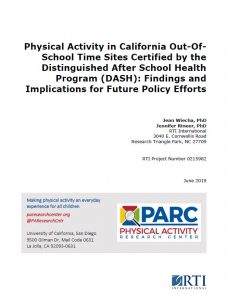Findings and Implications for Future Policy Efforts
Physical activity helps children stay physically fit, and reduce the risk for obesity, anxiety and other chronic diseases. Current U.S. guidelines call for children to get at least 60 minutes of physical activity daily but they are far from meeting these goals. With over 10 million children attending afterschool programs in the U.S. each year, including about 1.6 million in California alone, out-of-school time (OST) programs offer a promising setting for increasing children’s physical activity.
The California Distinguished After School Health (DASH) Recognition Program was the first state-legislated voluntary recognition program in OST focused on healthy eating and physical activity. Out-of-school time programs in California elementary and middle schools serving a high proportion of children from low-income families were eligible for the DASH Program to promote healthy eating and physical activity. The program included certification that participating programs met 10 program standards in health education, healthy eating, nutrition education, physical activity and screen time.
This study evaluated the policy for quality and technical assistance issues in delivering physical activity in DASH-certified programs. The primary research questions focus on understanding (1) how programs that apply for DASH certification differ from non-applicants on a range of characteristics and practices, (2) why some programs decide not to apply, and (3) identifying technical assistance needs to improve DASH compliance.
Key findings
- The most common physical activity session length was 30-35 minutes in which 36% of the time (or approximately 10 minutes) was spent on instruction and management and not on physical activity.
- The longer the session, the more MVPA time we observed, with boys being more active than girls. This finding is consistent with earlier studies of physical education, which have also shown that children typically attain MVPA for less than half of each class, and that boys are more active than girls (e.g., Lonsdale et al., 2013; McKenzie et al., 2004; Nader, 2003).
- Observations and staff interviews at DASH certified sites suggest that the amount of physical activity varies among sites. Some staff interpreted the DASH standard as a guideline for session length rather than for children’s activity time per se, and others noted that variation in children’s motivation and ability, session content, weather and other factors were influential.
Implications
During our evaluation, the program was allowed to sunset for a range of reasons, including concerns that relatively few programs applied to it and that quality was difficult to validate. Support for continuing DASH was also low due to its isolation from other related quality improvement legislation and its lack of funding for capacity building.
Although DASH ended, efforts to improve physical activity in OST are ongoing in California and other states. Findings from this study reinforce that, in order for children to receive adequate MVPA at OST programs, policies should:
- Include field-tested, clear language that clearly communicates whether time requirements refer to activity time offered or achieved;
- Facilitate access to training and technical assistance on how to maximize activity time, reduce management and instruction time, and ensure girls and boys are equally active;
- encourage physical activity periods that are long enough to accommodate instruction while Allowing children to accrue adequate MVPA;
- Include a mechanism for ongoing quality assurance; and
- Allow for modest levels of day-to-day variability at the classroom and child level, without allowing that variability to weaken activity goals.
Download the 17-page full report (PDF) and 2-page lay summary (coming soon).
Learn more about the project and research team here.
Suggested Citation:
Wiecha J & Rineer J. Physical Activity in California Out-of-School Time Sites Certified by the Distinguished After School Health Program (DASH): Findings and Implications for Future Policy Efforts. Research Triangle Park, NC: RTI International; 2019. Available at: https://paresearchcenter.org/wp-content/uploads/2019/07/PARC_RTI_DASH_Report_June.2019.pdf.

